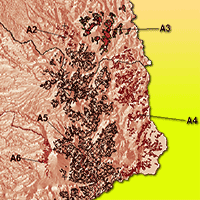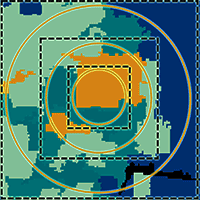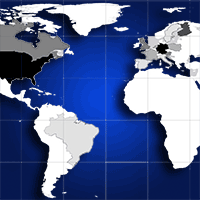
Fragmentation of Araucaria araucana forests in Chile: quantification and correlation with structural variables
Juan Ramón Molina (1) , Ángela Martín (2), Fernando Drake (3), Luis Miguel Martín (4), Miguel Ángel Herrera (1)
iForest - Biogeosciences and Forestry, Volume 9, Issue 2, Pages 244-252 (2015)
doi: https://doi.org/10.3832/ifor1399-008
Published: Aug 28, 2015 - Copyright © 2015 SISEF
Research Articles
Abstract
Landscape fragmentation is one of the main threats to South American temperate forests due to population growth, conversion of native forests to plantations of exotic species and non-sustainable timber harvesting. The lack of forest connectivity can interfere with pollination, seed dispersal, biodiversity and landscape quality. Species with relatively limited seed dispersal are potentially more sensitive to the landscape fragmentation. Araucaria araucana (Mol.) K. Koch is a long-lived, slow-growing, relict conifer in South America’s temperate forests with large seeds possessing a limited dispersal range. The objective of the study was to identify priority areas for Araucaria conservation based on fragmentation quantification and correlation with structural variables and regeneration conditions. Results from the FRAGSTATS® and CONEFOR® software indicated that Araucaria connectivity has increased in sites located in the central Andean Range in comparison to other sites, because of reduced human and livestock pressure as well as the relative absence of commercial plantations. The proximity index ranged from 6.01 m to 34834.2 m, and the probability of connectivity has significantly increased (175663 ha) in the central Andean Range. Significant relationships were found between the Simpson’s index (or the probability of connectivity) and basal area, and between the mean largest patch index and crown diameter. The largest patch index (r = 0.6; p < 0.05) and the area-weighted mean proximity index (r = 0.767; p < 0.05) were the most important landscape metrics influencing Araucaria regeneration. Furthermore, the integration of spatial pattern analysis obtained from satellite images and aerial photographs with forest and regeneration characterization from field sampling allowed to identify the most vulnerable areas. The methodology presented here can assist in the identification of target areas for spatial conservation, including management needs under the current budget restrictions.
Keywords
Landscape Conservation, Landscape Metrics, Landscape Connectivity, Spatial Pattern Indicators
Authors’ Info
Authors’ address
Miguel Ángel Herrera
Departamento de Ingeniería Forestal, Escuela Técnica Superior de Ingeniería Agronómica y de Montes, Edificio Leonardo Da Vinci, Campus de Excelencia Internacional Agroalimentario (ceiA3), Universidad de Córdoba, ES-14071 Córdoba (Spain)
Departamento de Ingeniería del Medio Agronómico y Forestal, Avda. Virgen del Puerto 2, Centro Universitario de Plasencia, Universidad de Extremadura, ES-10600 (Spain)
Departamento de Manejo de Bosques y Medioambiente, Facultad de Ciencias Forestales, Universidad de Concepción, Casilla 160-C, Concepción (Chile)
Departamento de Genética, Escuela Técnica Superior de Ingeniería Agronómica y de Montes, Edificio Gregor Mendel, Campus de Excelencia Internacional Agroalimentario (ceiA3),Universidad de Córdoba, ES-14071 Córdoba (Spain)
Corresponding author
Paper Info
Citation
Molina JR, Martín Á, Drake F, Martín LM, Herrera MÁ (2015). Fragmentation of Araucaria araucana forests in Chile: quantification and correlation with structural variables. iForest 9: 244-252. - doi: 10.3832/ifor1399-008
Academic Editor
Matteo Garbarino
Paper history
Received: Jul 14, 2014
Accepted: May 04, 2015
First online: Aug 28, 2015
Publication Date: Apr 26, 2016
Publication Time: 3.87 months
Copyright Information
© SISEF - The Italian Society of Silviculture and Forest Ecology 2015
Open Access
This article is distributed under the terms of the Creative Commons Attribution-Non Commercial 4.0 International (https://creativecommons.org/licenses/by-nc/4.0/), which permits unrestricted use, distribution, and reproduction in any medium, provided you give appropriate credit to the original author(s) and the source, provide a link to the Creative Commons license, and indicate if changes were made.
Web Metrics
Breakdown by View Type
Article Usage
Total Article Views: 52322
(from publication date up to now)
Breakdown by View Type
HTML Page Views: 42679
Abstract Page Views: 3602
PDF Downloads: 4649
Citation/Reference Downloads: 30
XML Downloads: 1362
Web Metrics
Days since publication: 3769
Overall contacts: 52322
Avg. contacts per week: 97.18
Citation Metrics
Article Citations
Article citations are based on data periodically collected from the Clarivate Web of Science web site
(last update: Mar 2025)
Total number of cites (since 2016): 12
Average cites per year: 1.20
Publication Metrics
by Dimensions ©
Articles citing this article
List of the papers citing this article based on CrossRef Cited-by.
References
Recopilación de datos climáticos de Chile y mapas sinópticos respectivos [Climate data collection of Chile and their respective synoptic maps]. Ministerio de Agricultura. Santiago, Chile, pp. 195. [in Spanish]
Gscholar
Efecto de la fragmentación forestal sobre la estructura vegetacional de las poblaciones amenazadas de Legrandia concinna (Myrtaceae) del centro-sur de Chile [Effect of forest fragmentation on vegetation structure of Legrandia concinna (Myrtaceae) threatened populations in south-central Chile]. Revista Chilena de Historia Natural 80: 27-42. [in Spanish]
CrossRef | Gscholar
Patterns of exotic species richness of different taxonomic groups in a fragmented landscape of central Chile. Bosque 34 (1): 45-51.
Gscholar
Producción y dispersión de semillas de Araucaria araucana (Mol.) C. Koch. en Lonquimay [Seed production and dispersal of Araucaria araucana (Mol.) C. Koch. in Lonquimay]. PhD Thesis, Facultad de Ciencias Agrarias y Forestales, University of Chile, Santiago, Chile, pp. 66. [in Spanish]
Gscholar
Fundamentos de teledetección espacial [Fundamentals of remote sensing]. Ediciones RIALP, Madrid, Spain, pp. 447. [in Spanish]
Gscholar
Catastro y evaluación de los recursos vegetacionales nativos de Chile. Informe nacional con variables ambientales [Land registry and evaluation of native vegetation resources of Chile. National Report with environmental variables]. CONAF, CONAMA, BIRF, Universidad Austral de Chile, Pontificia Universidad Católica de Chile, Universidad Católica de Temuco, Ministerio de Agricultura, Santiago, Chile, pp. 88. [in Spanish]
Gscholar
Bosques templados de Chile y Argentina. Variación, estructura y dinámica. Ecología forestal [Temperate forests of Chile and Argentina. Variation, structure and dynamics. Forest Ecology]. Edición Universitaria, Universidad de Chile, Santiago, Chile, pp. 484. [in Spanish]
Gscholar
Las especies arbóreas de los bosques templados de Chile y Argentina. Autoecología [Tree species in temperate forests of Chile and Argentine. Autecology]. Marisa Cúneo Ediciones. Valdivia, Chile, pp. 678. [in Spanish]
Gscholar
Uso sostenible en bosques de Araucaria araucana (Mol.) K. Koch. Aplicación de modelos de gestión [Sustainable Araucaria araucana (Mol.) K. Koch management. Management model alternatives]. PhD Thesis, University of Córdoba, Córdoba, Spain, pp. 318. [in Spanish]
Gscholar
What is the new? ERDAS Software 2009, version 9.3.2. Erdas Inc, Atlanta, Georgia, USA, pp. 12.
Gscholar
Araucaria araucana (Molina) K. Koch; Araucaria, Pehuén, Piñonero, Pino Araucaria, Pino chileno, Pino del Neuquén, Monkey puzzle tree. In: “Las especies arbóreas de los Bosques Templados de Chile y Argentina. Autoecología” [Tree species in temperate forests of Chile and Argentine. Autecology]. Marisa Cúneo Ediciones. Valdivia, Chile, pp. 36-53. [in Spanish]
Gscholar
Biodiversidad en ambientes fragmentados de Chile: patrones y procesos a diferentes escalas [Biodiversity in Chilean fragmented habitats: patterns and different scales]. Editorial Universitaria, Santiago, Chile, pp. 228. [in Spanish]
Gscholar
FRAGSTATS: spatial pattern analysis program for quantifying landscape structure. General Technical Report PNW-GTR 351, Pacific Northwest Research Station, USDA Forest Service, USA, pp. 122.
Gscholar
La bio-ecología de Araucaria araucana (Mol.) Koch [Bioecology of Araucaria araucana (Mol.) Koch]. Boletín del Instituto Forestal Latino-Americano de Investigación y Capacitación 46-48: 1-55. [in Spanish]
Gscholar
Impact of landscape and corridor design on primates in a large-scale industrial tropical plantation landscape. Biological Conservation 17 (5): 1105-1126.
Gscholar
Geomorfología, clima y suelos del tipo forestal Araucaria en Lonquimay [Geomorphology, climate and soils of Araucaria forest type in Lonquimay]. Boletín Técnico no 55, Facultad de Ciencias Forestales, Universidad de Chile, Santiago, Chile, pp. 117. [in Spanish]
Gscholar
Ecology of southern Chilean and Argentinean Nothofagus forests. In: “Ecology and biogeography of Nothofagus forests” (Veblen TT, Hill RS, Read J eds). Yale University Press, New Haven, USA, pp. 293-353.
Gscholar

















